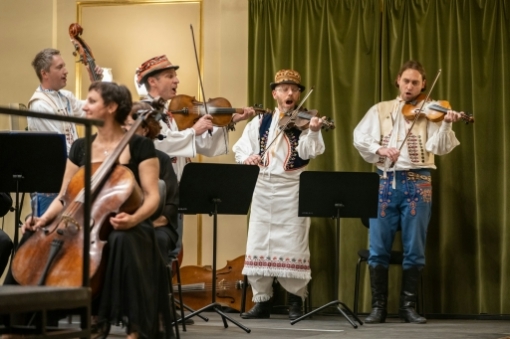The celebrations of the 100th anniversary of Brno’s Besední dům, which take place within its premises and elsewhere, have an interesting and distinguished dramaturgy that manages to transport the audience to the early days of this concert venue. Two concerts took place on 4 and 5 May and were entitled “Janáček” and “Horňácká muzika”. I took part in the first one; it was a truly momentous experience prepared by the Brno Philharmonic and Petr Mička’s Horňácká muzika. Friday’s repeat of the concert was broadcast by Czech Television. Both nights were sold out and standing tickets were even added to the sale.
The programme included music from Janáček’s ballet Rákos Rákozcy – a slightly controversial work which is partly based on his Wallachian and Lachian dances. The Brno Philharmonic was conducted by principal conductor Dennis Russel Davies and accompanied by Petr Mička’s Horňácká muzika. The musicians of this band have gotten used to cross-genre fusions, whether from the Hrubá hudba (Rough Music) project or more recently as accompaniment to rising star of the alternative scene Maria Puttnerová at her Brno album launch. They have also met Leoš Janáček, of course only through songs. They interpreted his Moravian folk poetry in songs with Jiří Pospíchal’s Quartet and Veronika Malatincová.
The inspiration for the Thursday and Friday concerts was the Lidový koncert (People’s Concert), which Leoš Janáček organised in 1892 in the Besední dům. In the patriotic environment of the time, it was common to bring folk music, which back then was still relatively lively, into an urban environment. The most striking example is the Czechoslovak Ethnographic Exhibition, for which Janáček was one of the main organisers three years later in Prague. He was in charge of the Moravian section. His collaborator at the time was another important collector of folk songs, František Bartoš.
Janáček got to know the Horňácko musicians from Pavel Trn’s music not only from his visits to the region, but also from a public concert in Uherské Hradiště in the spring of 1892. It is clear from several written sources that he was enthusiastic about Horňácko music in general, and about the music of Trn in particular. In this intoxication, he decided to invite the musicians to Brno.
The best known of the contemporary responses to the People’s Concert is Lubor Niederle’s review in the Český lid periodical. He stressed the mutual misunderstanding between the audience and the performers and jokingly remarked that the musicians would never be at home among the palm trees in the golden hall full of expectant spectators.
This may lead us to a deeper reflection on Janáček’s timelessness and the unconventionality with which he approached music and for which the audience may not have been prepared (even in this form). Whether they are ready for it today is also something to ponder.
In addition to Janáček’s arrangements of folk songs, the programme included works by Antonín Dvořák and the choirs of Pavel Křížkovský, all accompanied by Horňácko musicians and dancers.
The concert did not paraphrase the historical programme literally. Only Leoš Janáček’s music was chosen, i. e. the aforementioned Rákos Rakoczy, supplemented by five entries by Horňácko musicians from the music of Petr Mička.
The songs of the music were thematically linked to the programme of the philharmonic. Janáčkovy Pilky, for example, was complemented by the song Eště si já drobných desek narežu. I found the second half the most successful, where focus was placed not only on the thematic, but also the melodic and lyrical harmony of the given songs, for example with the song Rakúský císar pán.
Of course, the Czech Philharmonic Choir under the direction of Petr Fiala gave an equally professional performance. The singers were sometimes carried away by the folk lyrics to sway from side to side. I don’t know if this is what folk music should evoke in people, but in the end it was sympathetic. The conductor again seemed relaxed and the orchestra, augmented by four costumed musicians, was riveting in its performance. The minimalist choreographic elements of Horňácká muzika were so unobtrusive that I would have either omitted them or emphasised them more. My secret expectation that Petr Mička and his fellow players would sing in one of the numbers, accompanied by the entire Philharmonic Orchestra, was unfortunately not fulfilled.
The most remarkable thing about these hopelessly sold-out concerts is that they brilliantly demonstrate how Brno still loves Janáček and folklore. This was proven by the unceasing applause at the end (and actually in the middle) of the concert. Inspiration in folk music made Leoš Janáček a world-renowned composer. It is this inspiration by Janáček and folklore that can make Brno a world-renowned cultural metropolis. Perhaps a new modern concert house would help to achieve this, one that would be within metaphorical sight of the Besední dům. And it could even bear the name of Janáček himself.
































No comment added yet..